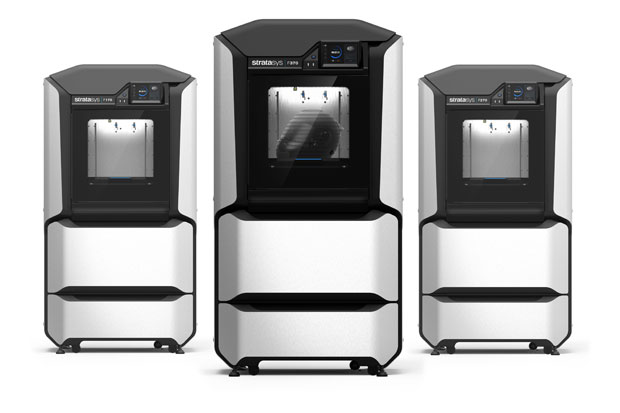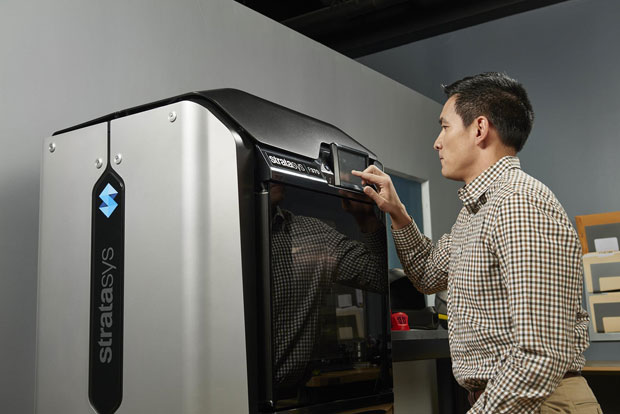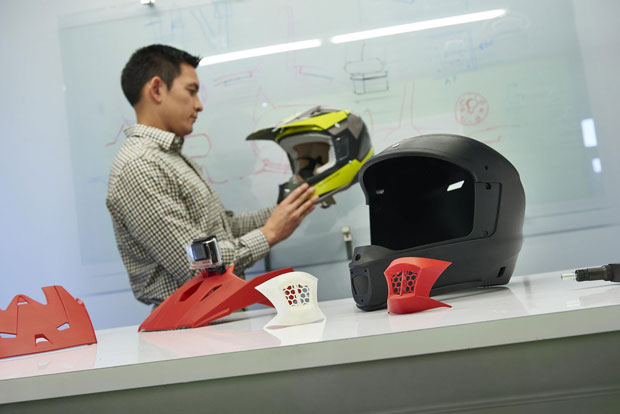Latest News
February 15, 2017
Stratasys Ltd. has unveiled a line new of professional-level FDM (Fused Deposition Modeling) 3D printers called the Stratasys F123 Series. Intended to address the requirements of design workgroups, the Stratasys F123 Series, says Stratasys, addresses the complete prototyping workflow from initial concept verification to design validation and final functional performance. The company adds that the series' ease of use enables virtually any user, regardless of 3D printing experience, to build durable and accurate prototypes using a range of functional FDM 3D printing materials.
 The new Stratasys F123 Series of 3D printers reportedly provide workgroups professional-level, engineering-grade quality to address the rapid prototyping workflow from initial concept designs through design validation and final functional performance. Image courtesy of Stratasys Ltd.
The new Stratasys F123 Series of 3D printers reportedly provide workgroups professional-level, engineering-grade quality to address the rapid prototyping workflow from initial concept designs through design validation and final functional performance. Image courtesy of Stratasys Ltd.The Stratasys F123 Series comes in three models—the F170, F270 and the F370. Designed to be office-friendly, each metal-cladded 3D print system measures 64x34x28 in. (1626x864x711 mm) and has a maximum noise specification of 46 dB during build and 35 dB when idle. The series is said to require minimal setup, and material replacements are easy.
All Stratasys F123 printers auto-calibrate, minimizing time spent troubleshooting. Walk-up operational features include a touch-screen user interface for most operations; however, users can operate Stratasys F123 Series 3D printers remotely from any networked computer in a shared workgroup setting. As well, users can monitor build progress from their portable devices.
Each system works with GrabCAD Print design-to-print software, a CAD-like application intended to simplify CAD file conversion and STL file preparation. Most commonly used CAD file formats can be imported directly into GrabCAD, according to Stratasys. The Stratasys F370 system also includes a license for Stratasys' Insight Software for slicing and generating support structures as well as material extrusion paths.
 Users can operate Stratasys F123 Series 3D printers remotely from any networked computer in a shared workgroup setting, and they can also monitor build progress from their portable devices. For walk-up operations, Stratasys F123 Series 3D printers have a touch-screen user interface. Image courtesy of Stratasys Ltd.
Users can operate Stratasys F123 Series 3D printers remotely from any networked computer in a shared workgroup setting, and they can also monitor build progress from their portable devices. For walk-up operations, Stratasys F123 Series 3D printers have a touch-screen user interface. Image courtesy of Stratasys Ltd.A GrabCAD Print Add-In for SOLIDWORKS that enables users to estimate and 3D print parts for a range of Stratasys systems, including the Stratasys F123 Series, without leaving the SOLIDWORKS environment is also available. The Stratasys F123 supports Windows 7, 8, 8.1 and 10 (64-bit) operating systems.
The series debuts a new fast-draft mode that lets users produce initial design concepts in PLA (polylactic acid) thermoplastic quickly and economically. This feature, says Stratasys, can 3D print models twice as fast as standard build mode while consuming just a third of the material on average.
Stratasys reports that Stratasys F123 Series printers have part accuracy within of +/- 0.008 in. (0.200 mm ) or +/- 0.002 in./in. (0.002 mm/mm), whichever is greater. Depending upon the 3D printer and material, layer thicknesses range from 0.013 in. (0.330 mm) for the Stratasys F170 printer to 0.005 in. (0.127 mm) for the Stratasys F370 system.
The Stratasys F170 model offers a maximum build size of 10x10x10 in. (XYZ; 254x254x254 mm), while the Stratasys F270 unit offers a 12x10x12 in. (305x254x305 mm) build size. The Stratasys F370's build size is 14x10x14 in. (355x254x355 mm).
The Stratasys F170 model has two material spool bays (one each for modeling and support materials) in a drawer on the front of the unit. Both the Stratasys F270 and F370 units provide four material spool bays (two each for modeling and support materials), which are also located in a front drawer.
 These motorcycle helmet prototypes were produced on the new Stratasys F370 3D printer at the Center for Advanced Design where they're being tested for design validation. Image courtesy of Stratasys Ltd.
These motorcycle helmet prototypes were produced on the new Stratasys F370 3D printer at the Center for Advanced Design where they're being tested for design validation. Image courtesy of Stratasys Ltd.In addition to PLA, the Stratasys F170 and F270 systems can use ABS-M30, a production-grade ABS (acrylonitrile butadiene styrene) material, and ASA (acrylonitrile styrene acrylate), a UV-resistant thermoplastic. The F370 supports those materials as well as PC-ABS (polycarbonate-ABS), a engineering-grade material for making impact-resistant parts. Users have their choice of 10 material colors.
“Today there is a vast market opportunity in product prototyping that we feel is not being addressed by current 3D printing systems,” said Zehavit Reisin, vice president, Head of Rapid Prototyping Solutions, Stratasys, in a press statement. “The Stratasys F123 Series targets product design workgroups, industrial designers, engineers, students and educators who demand a professional-quality rapid prototyping solution that's simple to use, produces reliable, engineering-quality results, integrates perfectly within an office or lab setting and is affordable to own and operate.”
In a related announcement, Stratasys, a SOLIDWORKS Partner Program member, announced a collaboration with Dassault Systemes' SIMULIA for improving additive manufacturing processes and parts through design optimization, print process simulation as well as strength and fatigue analysis.
The Stratasys F123 Series employs 15 new Stratasys patents in its design. For more information, click here.
Watch a video on the new Stratasys F123 Series of rapid prototyping solutions.
Subscribe to our FREE magazine, FREE email newsletters or both!
Latest News
About the Author
Anthony J. Lockwood is Digital Engineering’s founding editor. He is now retired. Contact him via [email protected].
Follow DE





